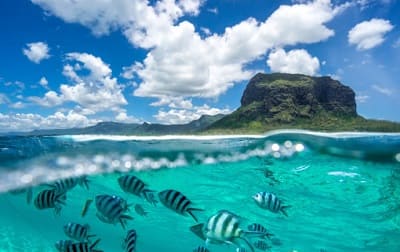Home › Scuba Diving Destinations › Asia › India
Best Scuba Diving in India
With a coastline that stretches 7,516 km, the Indian peninsular is a worthy destination for scuba divers to explore the diverse aquatic life.
This section contains an extensive list of India diving sites with information about the marine creatures that divers and snorkelers can find in this region in South Asia.
Where is there Good Scuba Diving in India?
India's unmistakable geographical entity borders three distinct marine biomes that captivate divers:
- Arabian Sea to the west (e.g. Goa, Netrani)
- Bay of Bengal in the east (Andaman Islands)
- Indian Ocean to the south (The Maldives)
As a result, scuba diving is growing fast and many of the top dive spots have yet to be discovered.
So, no matter what kind of water-based activity you want to try, there are plenty of scuba diving places in India for you to explore. The journey can start in Mumbia or Goa, and then you can go all the way round to the Andaman Islands.
Marine Life at India's Dive Spots
For the most part, the tropical water temperatures around the peninsular of India average 28° Celsius (80° to 84° Fahrenheit), and most of the dive sites have predictable water currents.
Some of the common marine life sightings that you should expect to see in India, especially between the months of December and April, include:
 Angelfish (Phylum: Chordata)
Angelfish (Phylum: Chordata)- Goliath groupers
- Manatees (Sirenia)
- Manta ray (Mobula)
- Mollusks (e.g. octopus, sea slugs)
- Reef sharks
- Stonefishes
- Whale sharks (extremely rare)
Top Dive Sites in India
Andaman and Nicobar Islands
The paradise archipelago of 572 Andaman and Nicobar Islands swathes in turquoise swimming-pools like water. The immaculate white beaches are straddled with gently swaying palms and vibrant blossoms.
This idyllic area of the Indian Ocean is a paradise that remains hidden from most of the human population. Diving and snorkeling in the islands of Andaman or Nicobar captivate the fantasy of genuine reef habitats and beauty of natural marine Eco-systems.
- Click through for more information about scuba diving in Andaman and Nicobar Islands and why this region rates among the best diving locations in all of India.
Goa
Diving around Goa is distinctly seasonal. During the better months through the winter of the northern hemisphere, the local dive sites are inviting and unforgettable.
The underwater clarity is "unstable". Even so, it offers a nurturing opportunity to develop varied and accomplished scuba skills. Fishes and coral patches dot the submerged pinnacles and remote islands off the coast of Goa.
- Check out a section that covers the best scuba diving in Goa for beginners and why India's smallest state is becoming a hub for water-based activities.
Kerala
The south-western state of Kerala is getting noticed as a popular location for divers. Most of the aquatic activities take place around Kovalam (e.g. in the Arabian Sea).
If you enjoy taking underwater photographs, then you'll appreciate the sandy-bottom dive sites in this area. Plus, scuba diving in Kovalam is ideal for divers of all certification levels, including novices.
Lakshadweep Islands
The 36 small-size islands of Lakshadweep rest more than two hundred kilometres from the coast of Malabar. The region's attractions are the coral sands and diverse flora.
The Agatti and Bangaram Islands are open to the public for scuba diving and snorkeling activities around the blue lagoons and natural reef formations within the Lakshadweep archipelago.
Netrani Island
Netrani is within easy reach of Goa and Mumbai for most divers. The heart shaped island in India is about ten (10) kilometres by boat from the coast of Karnataka - in the temple town of Murudeshwara.
If you enjoy scuba diving in the Arabian Sea off the west coast of India, you should add Netrani Island dive sites to your list of scuba destinations.
- Some of the most popular Netrani Island scuba diving sites have coral reefs, rocky pinnacles, and a few rusty old shipwrecks.
Puducherry
Tamil Nadu
The Maldive Islands
The Maldive Islands are famous for several reasons, but 26 atolls (clusters of coral reef) has to be the feature that interests scuba divers and snorkelers the most.
- Click through to a section containing information about the best scuba diving in Maldives and which marine species flourish in this part of the Indian Ocean.
Related Information and Help Guides
- A to Z Guide About Snorkeling for Beginners
- Complete List of Scuba Dive Equipment
- PADI Scuba Diving Certification Levels Explained
- Sea Life Creatures Facts and Species Information
- Where is the Best Dive Site in the World?
Pro Tip: The short video [3:01 minutes] presented by PADI® describes what it's like to get qualified for scuba diving in the incredible underwater scenery and pristine conditions of India.
Getting to India
Most travelers fly into the Chhatrapati Shivaji International Airport in Mumbai. From there, it's easy to get further flights to other regions and public transport to the coastal cities.